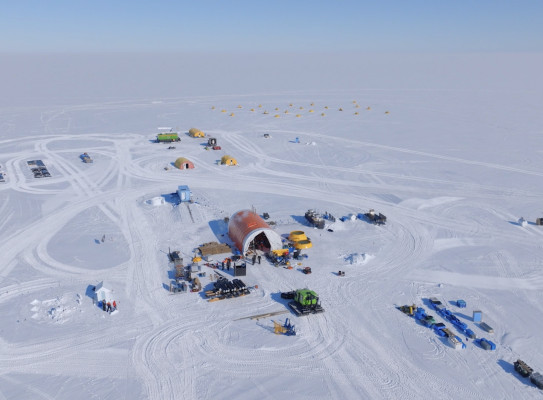
SWAIS2CSensitivity of the West Antarctic Ice Sheet to 2°C warming

SWAIS2C aims to determine how much the West Antarctic Ice Sheet melted during the last interglacial and other past times when climate was warmer than present, to better project how much sea-level rise to expect in our near future.
Overview
To look forward, we need to look back
Evidence from Earth’s past offers a glimpse into our future. In the last interglacial period, 125,000 years ago, global temperatures were 1 to 1.5°C warmer than pre-industrial times, similar to what we will see if carbon emissions targets, outlined in the Paris Agreement of the United Nations Framework Convention on Climate Change, are met.
Sea level may have been 6–9 metres higher due to ice melt – but it’s not yet clear how much the Greenland and Antarctic ice sheets melted. SWAIS2C aims to determine just how much the West Antarctic Ice Sheet (WAIS) melted during the last interglacial and other past times when climate was warmer than present.
About the project
SWAIS2C(external link) is an international initiative involving researchers from New Zealand, the United States, Germany, Australia, Italy, Japan, Spain, South Korea, the Netherlands, and the United Kingdom. New Zealand participation is supported through the Antarctic Science Platform’s Ice Dynamics Project.
Researchers, engineers, and drillers in the SWAIS2C Team will recover sediment cores from beneath the Ross Ice Shelf close to the grounding zone of the Kamb Ice Stream and Crary Ice Rise. No one has ever drilled deep into the Antarctic seabed at a location so far from a major base, and so close to the centre of the West Antarctic Ice Sheet.
These new records will help reveal how sensitive the Ross Ice Shelf and West Antarctic Ice Sheet were to past warming similar to the 1.5 to 2°C target set in the Paris Agreement.
Project operations are supported through funds from New Zealand, the United States, Germany, the United Kingdom, Australia, Japan, and the Republic of Korea. Support is also provided by the International Continental Scientific Drilling Programme (ICDP) via a grant for US$1.2 million dollars. This project is the first in Antarctica for ICDP(external link)
Antarctic field operations began in November 2023 and will continue through 2026.
This project aims to
- determine whether the West Antarctic Ice Sheet has advanced and retreated during the Holocene. This was a period of relatively stable climate that has characterised the last 10,000 years prior to the industrial revolution and the onset of the Anthropocene
- determine how marine-based ice sheets respond to a world that is 1.5–2°C warmer than pre-industrial times
- understand the local, regional, and global impacts and consequences of the response of the Antarctic ice sheet to this warming
To achieve these objectives, the project will
- Drill beneath the sea floor to recover sediment cores at two locations along the Siple Coast of West Antarctica where land-ice begins to float and form the Ross Ice Shelf. This region where the land-ice begins to float is called the grounding zone.
- Extract geological data from these sediment cores to reconstruct environmental conditions that characterised the drill sites as climate changed in the past. We will focus on periods of prior warmth to determine whether the Ross Ice Shelf disappeared and how far the grounding zone retreated or advanced.
- Use numerical models to simulate ice sheet response to these past intervals of warmth. Data from the drill cores will provide constraints for the models to test and enhance their ability to simulate prior environmental changes in West Antarctica.
The Project
Two drill sites
We will drill at two locations along the Siple Coast of West Antarctica. Kamb Ice Stream (KIS) is located beneath the floating ice shelf close to the grounding zone of the WAIS. Crary Ice Rise (CIR) ice sits directly on bedrock.
Our team and equipment will travel over 1,000km to the sites by over ice tractor train traverse and by air.
A tent camp will be established as our “home on ice” while we operate at each site for up to three months.
Technology
Our team of engineers has developed a new drilling system that we can transport hundreds of kilometres across the Ross Ice Shelf to the Siple Coast.
At the KIS site, we will melt a 35cm diameter hole through the 620m-thick ice shelf with a hot water drill to access the ocean water cavity below.
We will position our purpose-built light-weight drilling rig and lower a series of linked fiberglass pipes (riser) through the ice shelf hole to connect the surface to the sea floor.
A second series of linked steel pipe with a diamond encrusted rock coring bit is lowered inside the riser and will core into layers of sediment and rock up to 200m beneath the sea floor. There is no ocean cavity at the CIR site so we will drill directly into sediment and rock from the base of the hole in the ice shelf.
Layers of sediment record past environmental change
Mud-rich sediments that are devoid of microscopic marine life are accumulating in the dark and cold sub-ice shelf environment above the KIS site today.
Under previous colder-than-present climates – the last ice age – the WAIS advanced across the site and laid down sediment called diamictite that is characteristic of the depositional environment at the bottom of an ice sheet.
Under past warmer conditions warmer than present, the WAIS may have completely melted and the KIS site would have been covered by an open sea. Sediments that settled to the sea floor during these ice-free intervals likely included photosynthetic plankton (diatoms) that were flourishing in the open marine environment that occupied West Antarctica at the time.
Teamwork
Once the core has been recovered, it will be flown back to Scott Base and shipped to the Otago Repository for Core Analysis (ORCA) in Dunedin, New Zealand.
Our international team of scientists will meet at the core facility to describe and examine the core and sample it for further analysis at their home laboratories around the world.
Our ice sheet and climate modellers will join the team to develop experiments to simulate past environmental change using our new observations and data as guides and constraints (examples of models).
We aim to improve our understanding of ice sheet processes and refine the numerical models so that we can reduce uncertainty associated with Antarctic ice sheet behaviour and its contribution to sea level rise.

Research project details
Collaborators:
National: Antarctic Research Centre at Victoria University of Wellington, University of Otago, Antarctica New Zealand. We are also working with Craig Cary from University of Waikato
International: International Continental Scientific Drilling Program (ICDP), Bundesanstalt für Geowissenschaften und Rohstoffe, Germany (BGR), Alfred Wegener Institute, Germany (AWI), Korean Polar Research Institute of Marine Research Placement, Korea (KOPRI), Binghamton University, USA, Natural Environment Research Centre, UK (NERC), Imperial College London, Royal Netherlands Institute for Sea Research (NIOZ), National Science Foundation, USA, Istituto Nazionale di Geofisica e Vulcanologia (INGV) + many more
Duration
2021–2025
Funding platform
Antarctic Science Platform (MBIE), ICDP, BGR, AWI, NERC-UKRI, AuScope, ANZIC, Korea Polar Research Institute, National Science Foundation, INGV and NiPR (National Institute for Polar Research Japan). Logistics and Operations supported by: GNS Science, Antarctica New Zealand (MFAT), Victoria University of Wellington Te Herenga Waka
Status
Current
Leaders
Richard Levy (GNS Science/VUW)
Tina van de Flierdt (Imperial College London)
Molly Patterson (Binghamton University, USA)
Huw Horgan (VUW, ETH Zurich)